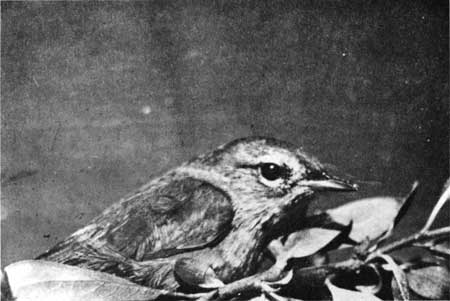|
Volume XVIII - 1952

Macgillivray warbler photographed in the headquarters
area. From a Kodachrome by Ranger-Naturalist Ralph Welles and Florence
Welles.
Ornithological Notes Of Interest
Summer Of 1952
By Donald S. Farner, Assistant Park Naturalist
The summer of 1952, by contrast with 1951, was unusual because of
the prolonged persistence of the snow and a consequently much delayed
season. Although causal relations must be assumed with the greatest of
caution and with much more investigation than has been possible, it is
nevertheless interesting to note certain differences between the two
seasons.
Several species whose upward altitudinal limits fluctuate
substantially were greatly reduced or entirely absent from elevations
above 6000 feet in contrast to last summer when the snow melted early.
Included in this group are the Lazuli Bunting, Passerina amoena
(Say); Fox Sparrow, Passerella iliaca (Merrem); and Western Wood
Pewee, Contopus richardsonii (Swainson). Also conspicuously
absent at higher elevations were Turkey Vultures, Cathartes aura
(Linnaeus).
Perhaps the most spectacular change in the avifauna from last summer
was the conspicuous decline in numbers of Red Crossbills, Loxia
curvirostra Linnaeus. During the summer of 1952 I saw about 0.9
crossbills per hour in the field compared to 5.5 per hour in 1951.
During 1952 they were only in restless flocks whereas in 1951 singing
males were observed commonly. Also in 1951 groups feeding in cones or
"mineral pecking" could be observed from small distances. Pine Siskins,
Spinus pinus (Wilson), however, continue to be common this
summer. Huge flocks of several hundred individuals were observed
frequently in the Headquarters Area during late July and early
August.
It is of interest, to note further, that there was a conspicuous
reduction in the numbers of Rosy Finches, Leucosticte tephrocotis
(Swainson). This has been particularly noticeable on Dutton Ridge where
they were very abundant during the summer of 1951.
There was also a reduction in the density of breeding Lincoln
Sparrows, Melospiza lincolnii (Audubon), in the higher montane
meadows. The study area in the upper Munson Meadow which I have had
under observation for several summers had only two, possibly three,
breeding pairs compared to the usual five or six. Although I do not have
quantitative data, a similar reduction appears to have occurred in other
high-elevation meadows. It seems quite likely that the persistence of
the snow in these areas may have been responsible. It should be noted
also that there has been a noticeable reduction in the numbers of
Dippers, Cinclus mexicanus Swainson, appearing in the upper
portions of the streams in mid-summer. Whether this represents a
reduction in population or a restrictive effect of the snow on the
normal mid-summer migration to higher elevations is not clear.
Despite the fact that there was a severe reduction in the cone crop
on the whitebark pine, ponderosa pine, and firs, compared with 1951,
there was, during the summer of 1952, a marked increase in Clark's
Nutcrackers, Nucifraga columbiana (Wilson). This is noticeable
throughout the high country as well as at the Rim Village, although more
pronounced at the latter. It is of interest to note that we saw a
considerable number of color-banded individuals which were banded during
the summer of 1950 but which failed to reappear during the summer of
1951. The movements of this species continue to be enigmatic! There was
also a remarkable increase in the number of Ravens, Corvus corax
Linnaeus, observed. At least three small flocks, probably family groups,
were observed repeatedly. These were commonly seen in the vicinity of
Park Headquarters, Rim Village, and the Watchman, respectively.
Also of interest were the substantially greater recorded numbers of
Booming Nighthawks, Chordeiles minor (Forster). Mr. and Mrs. Jack
D. Lee reported observing them nightly at Lost Creek in Pinnacle Valley.
I confirmed this on three occasions. They were apparently similarly
common in the Panhandle. I also observed nighthawks at Arant Point on
July 8 and above Castle Creek Canyon (5800 ft.) on August 5.
Several important observations were obtained on swallows. On July
28, I saw three Cliff Swallows, Petrochelidon pyrrhonota
(Vieillot), within the Crater wall near Garfield Peak. This is the
second record for the Park. On August 2, Ranger-naturalist C. F. Yocom
and I saw two Rough-winged Swallows along the Garfield Peak Trail. These
are the first records for the Park since 1937 and the first for the Lake
area. On July 19 I found a nest of Violet Green Swallows, Tachycineta
thalassina (Swainson), in a cavity in one of the Wheeler Creek
Pinnacles. This is the first breeding record for the Park.
Despite the heavy snow, the population reproductive activity, and
upward migration of Blue Grouse, Dendragapus obscurus (Say), was
quite normal.
References
Farner, Donald S. 1951. Ornithological notes of interest.
Crater Lake Nature Notes, 17:16-18.
Farner, Donald S. 1951. The Red Crossbill irruption of 1951.
Crater Lake Nature Notes, 17:19.
Farner, Donald S. 1952. The Birds of Crater Lake National
Park. University of Kansas Press, ix-200 pp.
A New Record In The Park For The Oregon Red Salamander
By James Kezer, Ranger-Naturalist
One of the rarest animals in Crater Lake National Park is the Oregon
red salamander. Lawrence Bisbee, foreman of the fire guards, found the
first specimen to be collected in the Park on August 7, 1951, under a
pile of boards near the Annie Spring Campground. Intensive search in
suitable habitats throughout the Park failed to reveal other specimens
until July 5, 1952. On that evening six additional specimens of this
salamander were found by a group of individuals under rocks and in
rotten wood at the edge of Vidae Falls. The Oregon red salamanders that
have been found in the Park are intergrades between two subspecies as is
indicated by the scientific name, Ensatina eschscholtzil
oregonensis x platensis. It is particularly interesting to
note that the Vidae Falls collection establishes a new altitude record
for this genus of salamanders - about 6700 feet in the Hudsonian life
zone.
| 
